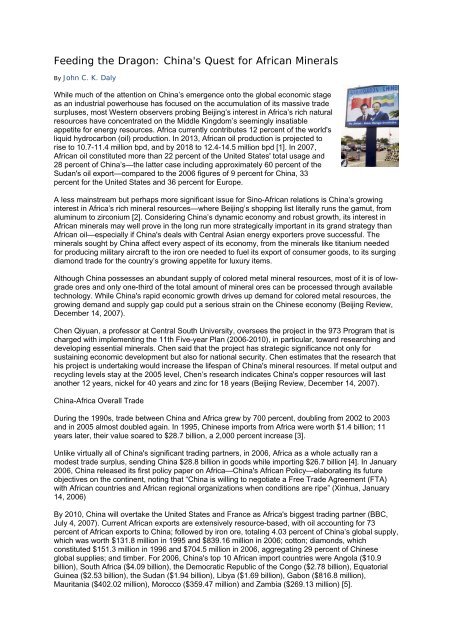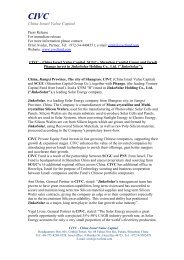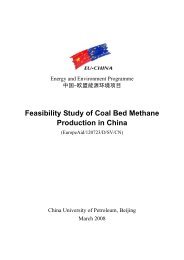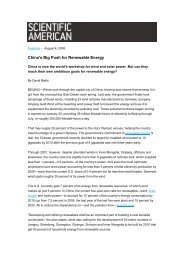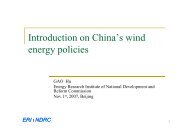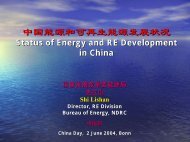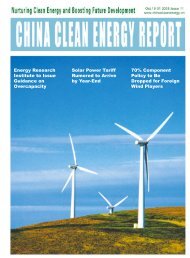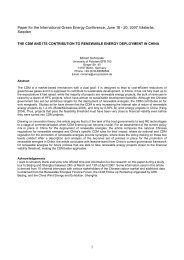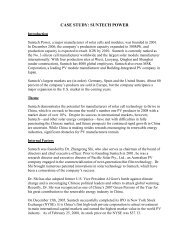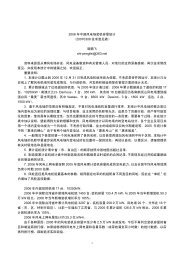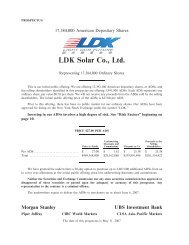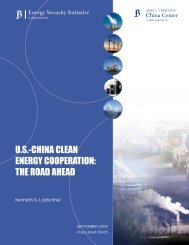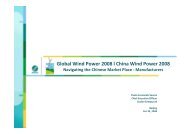Feeding the Dragon: China's Quest for African Minerals
Feeding the Dragon: China's Quest for African Minerals
Feeding the Dragon: China's Quest for African Minerals
Create successful ePaper yourself
Turn your PDF publications into a flip-book with our unique Google optimized e-Paper software.
<strong>Feeding</strong> <strong>the</strong> <strong>Dragon</strong>: <strong>China's</strong> <strong>Quest</strong> <strong>for</strong> <strong>African</strong> <strong>Minerals</strong><br />
By John C. K. Daly<br />
While much of <strong>the</strong> attention on China’s emergence onto <strong>the</strong> global economic stage<br />
as an industrial powerhouse has focused on <strong>the</strong> accumulation of its massive trade<br />
surpluses, most Western observers probing Beijing’s interest in Africa’s rich natural<br />
resources have concentrated on <strong>the</strong> Middle Kingdom’s seemingly insatiable<br />
appetite <strong>for</strong> energy resources. Africa currently contributes 12 percent of <strong>the</strong> world's<br />
liquid hydrocarbon (oil) production. In 2013, <strong>African</strong> oil production is projected to<br />
rise to 10.7-11.4 million bpd, and by 2018 to 12.4-14.5 million bpd [1]. In 2007,<br />
<strong>African</strong> oil constituted more than 22 percent of <strong>the</strong> United States' total usage and<br />
28 percent of China’s—<strong>the</strong> latter case including approximately 60 percent of <strong>the</strong><br />
Sudan's oil export—compared to <strong>the</strong> 2006 figures of 9 percent <strong>for</strong> China, 33<br />
percent <strong>for</strong> <strong>the</strong> United States and 36 percent <strong>for</strong> Europe.<br />
A less mainstream but perhaps more significant issue <strong>for</strong> Sino-<strong>African</strong> relations is China’s growing<br />
interest in Africa’s rich mineral resources—where Beijing’s shopping list literally runs <strong>the</strong> gamut, from<br />
aluminum to zirconium [2]. Considering China’s dynamic economy and robust growth, its interest in<br />
<strong>African</strong> minerals may well prove in <strong>the</strong> long run more strategically important in its grand strategy than<br />
<strong>African</strong> oil—especially if <strong>China's</strong> deals with Central Asian energy exporters prove successful. The<br />
minerals sought by China affect every aspect of its economy, from <strong>the</strong> minerals like titanium needed<br />
<strong>for</strong> producing military aircraft to <strong>the</strong> iron ore needed to fuel its export of consumer goods, to its surging<br />
diamond trade <strong>for</strong> <strong>the</strong> country’s growing appetite <strong>for</strong> luxury items.<br />
Although China possesses an abundant supply of colored metal mineral resources, most of it is of lowgrade<br />
ores and only one-third of <strong>the</strong> total amount of mineral ores can be processed through available<br />
technology. While <strong>China's</strong> rapid economic growth drives up demand <strong>for</strong> colored metal resources, <strong>the</strong><br />
growing demand and supply gap could put a serious strain on <strong>the</strong> Chinese economy (Beijing Review,<br />
December 14, 2007).<br />
Chen Qiyuan, a professor at Central South University, oversees <strong>the</strong> project in <strong>the</strong> 973 Program that is<br />
charged with implementing <strong>the</strong> 11th Five-year Plan (2006-2010), in particular, toward researching and<br />
developing essential minerals. Chen said that <strong>the</strong> project has strategic significance not only <strong>for</strong><br />
sustaining economic development but also <strong>for</strong> national security. Chen estimates that <strong>the</strong> research that<br />
his project is undertaking would increase <strong>the</strong> lifespan of <strong>China's</strong> mineral resources. If metal output and<br />
recycling levels stay at <strong>the</strong> 2005 level, Chen’s research indicates <strong>China's</strong> copper resources will last<br />
ano<strong>the</strong>r 12 years, nickel <strong>for</strong> 40 years and zinc <strong>for</strong> 18 years (Beijing Review, December 14, 2007).<br />
China-Africa Overall Trade<br />
During <strong>the</strong> 1990s, trade between China and Africa grew by 700 percent, doubling from 2002 to 2003<br />
and in 2005 almost doubled again. In 1995, Chinese imports from Africa were worth $1.4 billion; 11<br />
years later, <strong>the</strong>ir value soared to $28.7 billion, a 2,000 percent increase [3].<br />
Unlike virtually all of <strong>China's</strong> significant trading partners, in 2006, Africa as a whole actually ran a<br />
modest trade surplus, sending China $28.8 billion in goods while importing $26.7 billion [4]. In January<br />
2006, China released its first policy paper on Africa—<strong>China's</strong> <strong>African</strong> Policy—elaborating its future<br />
objectives on <strong>the</strong> continent, noting that “China is willing to negotiate a Free Trade Agreement (FTA)<br />
with <strong>African</strong> countries and <strong>African</strong> regional organizations when conditions are ripe” (Xinhua, January<br />
14, 2006)<br />
By 2010, China will overtake <strong>the</strong> United States and France as Africa's biggest trading partner (BBC,<br />
July 4, 2007). Current <strong>African</strong> exports are extensively resource-based, with oil accounting <strong>for</strong> 73<br />
percent of <strong>African</strong> exports to China; followed by iron ore, totaling 4.03 percent of China’s global supply,<br />
which was worth $131.8 million in 1995 and $839.16 million in 2006; cotton; diamonds, which<br />
constituted $151.3 million in 1996 and $704.5 million in 2006, aggregating 29 percent of Chinese<br />
global supplies; and timber. For 2006, <strong>China's</strong> top 10 <strong>African</strong> import countries were Angola ($10.9<br />
billion), South Africa ($4.09 billion), <strong>the</strong> Democratic Republic of <strong>the</strong> Congo ($2.78 billion), Equatorial<br />
Guinea ($2.53 billion), <strong>the</strong> Sudan ($1.94 billion), Libya ($1.69 billion), Gabon ($816.8 million),<br />
Mauritania ($402.02 million), Morocco ($359.47 million) and Zambia ($269.13 million) [5].
China and South Africa<br />
Out of <strong>the</strong> 54 countries and <strong>the</strong> island territories in Africa, Beijing regards South Africa as <strong>the</strong><br />
continent’s mineralogical treasure house. South Africa is <strong>the</strong> largest producer of gold—currently<br />
accounting <strong>for</strong> 14 percent of total global production and containing 40.1 percent of <strong>the</strong> world’s known<br />
reserves—and contains 87.7 percent of <strong>the</strong> world’s platinum reserves, 80 percent of its manganese<br />
ore, 72.4 percent of its chrome ore and 27 percent of its vanadium [6]. In 2006, gold accounted <strong>for</strong> 20<br />
percent of South Africa’s exports, while coal, platinum and o<strong>the</strong>r minerals made up an additional 25<br />
percent [7]. South Africa also has substantial reserves of o<strong>the</strong>r industrially important metals and<br />
minerals [8].<br />
Between 1996 and 2005, South <strong>African</strong> exports to China increased to well over $1.25 billion. China<br />
reciprocally has invested $130 million in South Africa, mostly in <strong>the</strong> Buffelsfontein chromium mine<br />
(BuaNews, January 9). According to South <strong>African</strong> Revenue Service trade data, in 2007, South <strong>African</strong><br />
exports to China rose 195 percent compared with <strong>the</strong> same period in 2006, to $2.26 billion, behind<br />
Japan, <strong>the</strong> United States, Germany and Britain (Business Report [South Africa], September 14, 2007).<br />
South Africa accounts <strong>for</strong> about 75 percent of world ferrochrome, and China now imports over 90<br />
percent of <strong>the</strong> ferrochrome consumed by its voracious stainless steel industry.<br />
China is not alone in its interest in South <strong>African</strong> minerals; <strong>the</strong> United States is also heavily dependent<br />
upon South Africa <strong>for</strong> key minerals including chrome, manganese, vanadium and platinum. In<br />
February 1987, <strong>the</strong>n President Ronald Reagan certified andalusite, antimony, chrysotile asbestos,<br />
chromium, cobalt, industrial diamonds, manganese, platinum group metals, rutile and vanadium as<br />
“strategic” minerals that were considered essential <strong>for</strong> supplying military, industrial and civilian needs<br />
of <strong>the</strong> United States at <strong>the</strong> time of a national emergency; moreover, <strong>the</strong>y are not sufficiently found or<br />
produced in <strong>the</strong> United States [9].<br />
<strong>China's</strong> Voracious Appetite <strong>for</strong> <strong>Minerals</strong><br />
China’s outreach <strong>for</strong> minerals and resources to supply its economy have had a global impact; since<br />
2005, many commodity prices have soared—gold and silver are again reaching price heights not seen<br />
since <strong>the</strong> late 1970s, while in 2007 prices <strong>for</strong> copper, zinc, lead, tin, chromium, platinum, molybdenum,<br />
coal, oil and uranium also set multi-year or all-time highs [10].<br />
China now consumes 30 percent of <strong>the</strong> global total <strong>for</strong> zinc and 25 percent of that of lead, while since<br />
1996 <strong>China's</strong> consumption of refined copper has risen from less than 10 percent of world demand to<br />
22 percent, and <strong>the</strong> Chinese economy absorbs 27 percent of <strong>the</strong> globe’s iron and steel and 25 percent<br />
of its aluminum. China already produces one-third of <strong>the</strong> world's steel, and its iron ore imports are<br />
expected to double by 2012. In 2003, China passed <strong>the</strong> United States to become <strong>the</strong> world’s largest<br />
copper consumer and by <strong>the</strong> following year consumed 46 percent more than <strong>the</strong> United States. In<br />
2006, China announced plans to set up Strategic Mineral Reserve to stockpile uranium, copper,<br />
aluminum, iron ore and o<strong>the</strong>r minerals. The reserves are critical <strong>for</strong> providing China with a buffer to<br />
adjust to market fluctuations, manage emergencies and guarantee <strong>the</strong> security of resource supplies<br />
[11].<br />
<strong>China's</strong> <strong>African</strong> Resource Acquisition Investment Strategy<br />
The general patterns of Chinese investment in Africa are discernible and differ in many respects from<br />
Western attitudes. First and <strong>for</strong>emost, China in its long-term view has concluded that Africa’s overall<br />
macroeconomic situation is improving, despite <strong>the</strong> problems wracking <strong>the</strong> continent—from corruption<br />
to civil war—giving it a much bolder position on investment than more cautious Western investors.<br />
Chinese producers also see Africa as a continent of immense opportunity <strong>for</strong> <strong>the</strong>ir lost-cost products,<br />
which in most cases undercut higher-priced Western imports. The final element in Beijing’s perception<br />
of Africa is a keenly focused awareness of <strong>the</strong> continent’s rich resource base; while Western<br />
competitors also covet Africa’s mineralogical resources, Chinese investment strategy benefits from<br />
Western deficits and <strong>the</strong>re<strong>for</strong>e holds advantages over European and American approaches. Western<br />
and European investors arrive with ideological baggage and domestic constraints in <strong>the</strong> <strong>for</strong>m of<br />
economic re<strong>for</strong>m, anti-corruption and human rights campaigns—a key aspect of China’s policies<br />
toward <strong>the</strong> continent is its avowedly apolitical and amoral stance described as “non-interference in<br />
domestic affairs.” Adding to <strong>the</strong> appeal of China’s “soft power” is an appreciation of a half-century<br />
history of friendly ties and past Chinese support <strong>for</strong> liberation movements in Africa, topped off with <strong>the</strong><br />
provision of “no-strings-attached” financial and technical aid to <strong>African</strong> countries. These deals often
include low-interest or interest-free loans and additional funding <strong>for</strong> both developing infrastructure and<br />
civil projects.<br />
A prime example is Chinese investment in Angola. China invested in Angola’s oil industry even as civil<br />
war raged, in 1995 exporting $135.7 million worth of hydrocarbons. Since <strong>the</strong> nation ended a 27-year<br />
civil war in 2002, Angola has become China’s largest trading partner, in 2006 surpassing Saudi Arabia<br />
as China’s leading oil exporter, and has <strong>the</strong> fastest-growing economy on <strong>the</strong> continent with a projected<br />
2007 gross domestic product (GDP) growth rate of over 20 percent. In 2006, Angola exported $10.93<br />
billion of oil to China and joined OPEC, but two-thirds of <strong>the</strong> population is estimated to earn less than a<br />
dollar a day. This has provided an opportunity <strong>for</strong> <strong>the</strong> opposition, with Unita party leader Isaias<br />
Samakuva commenting, "What we have seen is that Angolans have not benefited from <strong>the</strong> accords<br />
with China. These are aspects that need to be looked at carefully and see how <strong>the</strong>y can be bettered"<br />
(Cruzeiro do Sul, January 12, 2007).<br />
China has landed some impressive deals throughout Africa, including winning a majority stake in <strong>the</strong><br />
Democratic Republic of <strong>the</strong> Congo’s (DRC) Gecamines joint venture. In return <strong>for</strong> a $5 billion loan, <strong>the</strong><br />
DRC government is giving four Chinese state enterprises a 68 percent stake in a joint venture with<br />
Gecamines, <strong>the</strong> state-owned mining company, in addition to China Overseas Engineering’s $300<br />
million investment in two Congolese copper and cobalt mining projects [12]. In ano<strong>the</strong>r coup, in June<br />
2006, China beat out Brazil’s Vale do Rio Doce—<strong>the</strong> world’s top iron ore producer—and French<br />
company Eramet to secure a $3 billion contract to develop massive iron ore reserves in Belinga,<br />
Gabon. During <strong>the</strong> China-Africa Summit in November 2006, among <strong>the</strong> agreements concluded by<br />
China were a $938 million contract to develop an aluminum plant in Egypt and a $230 million deal <strong>for</strong><br />
ferrochrome mining and smelting in South Africa.<br />
These investments do not come without risks: on April 24, 2007, a guerrilla attack on a Chinese-run oil<br />
field in Ethiopia left 77 people dead. Since 2004, dozens of Chinese workers, engineers and o<strong>the</strong>r<br />
civilians have been killed or kidnapped in Nigeria, Kenya and o<strong>the</strong>r <strong>African</strong> states. Moreover, <strong>African</strong><br />
workers in Angola, Zambia, Nigeria and Morocco have demonstrated over Chinese labor policies,<br />
most notably at Zambia’s Chambishi copper mine, where on January 3, 500 workers went on strike to<br />
protest low salaries and poor working conditions, with one worker representative commenting that<br />
salaries were as low as $54 per month (The Times of Zambia, January 4).<br />
China’s extensive operations in <strong>the</strong> Sudan have also attracted intense international criticism <strong>for</strong><br />
fraternizing with a supporter of terrorism involved in a brutal campaign in Darfur, an ongoing legacy of<br />
<strong>the</strong> Sudan's ongoing 24-year civil war. The international community also deplores China’s deepening<br />
relationship with Mugabe’s despotic regime, but Beijing instead focuses on projections that in 2008<br />
trade between Zimbabwe and China is set to increase to $500 million (The Herald, January 7). In<br />
December 2007, Sinosteel Corporation acquired a 67 percent stake in Zimbabwe's leading<br />
ferrochrome producer and exporter Zimasco Holdings (The Herald, December 20, 2007).<br />
Despite <strong>the</strong> problems enumerated above, <strong>the</strong> possibilities <strong>for</strong> <strong>the</strong> future of Chinese-<strong>African</strong> trade seem<br />
limitless. According to South <strong>African</strong> mining executive Sir Sam Jonah, only 30 percent of Africa has<br />
been explored <strong>for</strong> mineral wealth (The Gibbs Review, January 2006, Vol. 01.). The only question, in an<br />
increasingly resource-hungry world, is whe<strong>the</strong>r Africa’s riches go East or West.<br />
Conclusion<br />
<strong>China's</strong> Africa strategy—which is tied to over 50 years of ideological solidarity, beginning when <strong>the</strong><br />
continent was struggling to liberate itself from colonialism—is now paying immense economic<br />
dividends. <strong>China's</strong> willingness to invest heavily in <strong>African</strong> nations ei<strong>the</strong>r currently wracked by civil<br />
war—such as <strong>the</strong> Sudan and <strong>the</strong> Democratic Republic of <strong>the</strong> Congo—or recently emerged from<br />
chaos—such as Angola—has given it a leading position in development projects that more timorous<br />
Western investors up to now have largely avoided. Given <strong>the</strong> relative political stability of Africa, it<br />
remains a high-risk strategy. For Beijing to maintain <strong>China's</strong> impressive growth record, however, <strong>the</strong>re<br />
is really little choice, as American and European investors have already locked up many of <strong>the</strong> globe's<br />
more stable sources of raw materials. It remains to be seen whe<strong>the</strong>r <strong>China's</strong> Africa policy will<br />
ultimately become a system that pacifies <strong>the</strong> continent, or possibly leads to ei<strong>the</strong>r covert or overt<br />
“resource wars” <strong>for</strong> <strong>the</strong> limited supply of both hydrocarbons and strategic minerals. <strong>China's</strong> policy, at<br />
least as regards what Washington defines as strategic minerals, could certainly become a disruptive<br />
influence in Washington-Beijing relations. Given <strong>China's</strong> oft-stated commitment to global peaceful<br />
development, it remains to be seen how such a confrontation might play out. Considering
Washington's establishment last year of its AFRICOM military command, <strong>the</strong>re seems little doubt that<br />
in <strong>the</strong> event of armed confrontation Beijing would be <strong>the</strong> loser. China clearly prefers <strong>the</strong> economic<br />
benefits of peaceful trade; as <strong>the</strong> wars in Afghanistan and Iraq so vividly illustrate, armed conflict is a<br />
net consumer of men, material and money and it is obvious that <strong>for</strong> <strong>the</strong> present Beijing is trying to<br />
avoid such a path.<br />
Notes<br />
1. First <strong>African</strong> Union Conference of Ministers Responsible <strong>for</strong> Hydrocarbons (Oil and Gas), December<br />
11-15, 2006, Cairo, Egypt, sourced at http://www.africaunion.org/root/AU/Conferences/Past/2006/November/infrastructure/doc/en/AU_EXP_OG_5_Fuelling_<br />
Eng.doc.<br />
2. China’s extensive shopping list <strong>for</strong> <strong>African</strong> minerals includes: aluminum; asbestos; basalt; boric<br />
acids and oxides; carbonates; chromium ore and concentrates; coal; cobalt ore and concentrates;<br />
diamonds; feldspar; ferroalloys; fluorspar; gold; granite; iron ores and concentrates; lead ore and<br />
concentrates; leucite; manganese ores and concentrates, including ferrous manganese iron ore; lime;<br />
molybdenum ore and concentrates; nepheline; nickel; niobium; syenite; oxometallic and<br />
peroxometallic acid salts; platinum; porphyry; silver; slacked lime; tin ore and concentrates; titanium<br />
oxides; tungsten ore and concentrates; quartz; quartzite; quicklime; tantalium; vanadium; zinc and<br />
zirconium ore and concentrates (World Trade Atlas—Index <strong>for</strong> Chinese Trade Data, Chinese Customs,<br />
Trade Law Centre <strong>for</strong> Sou<strong>the</strong>rn Africa).<br />
3. See World Trade Atlas, “Index <strong>for</strong> Chinese Trade Data–Dec. Years (ranked by Chinese imports),”<br />
Trade Law Centre <strong>for</strong> Sou<strong>the</strong>rn Africa, sourced at<br />
http://www.tralac.org/pdf/20070220_China_Africa_top20s2007.xls<br />
4. Ibid.<br />
5. Ibid.<br />
6. <strong>Minerals</strong> Bureau, “South Africa’s mineral reserves 2005,” 2006/2007, South Africa Yearbook: 16—<br />
Mineral, energy and geology. www.gcis.gov.za/docs/publications/yearbook/chapter16.pdf<br />
7. Esipp Mines 2006: Country Profile: South Africa.<br />
www.mines2006.com/Downloads/EN/SADC%20Mining%20Industry%20Review_MINES%202006.pdf<br />
8. These minerals include antimony, asbestos, diamonds, coal, fluorspar, phosphates, iron ore, lead,<br />
zinc, uranium, vermiculite and zirconium. South Africa is <strong>the</strong> world's largest producer of gold, platinum<br />
group metals, vanadium and alumino-silicates, as well as one of <strong>the</strong> world's top five producers of<br />
antimony, chromite, diamonds, ferrochrome, ferro-manganese, fluorspar, manganese, titanium,<br />
vermiculite and zirconium.<br />
9. Natalie Johnson, "Strategic <strong>Minerals</strong> in <strong>the</strong> United States," sourced at<br />
http://www.emporia.edu/earthsci/amber/go336/natalie/newindex.htm<br />
10. Michael Dynes, “Africa's Biggest Fan,” March 1, 2006, sourced at http://www.africainvestor.com/article_mag.asp?id=507&magazineid=11<br />
11. Metals prices have completed <strong>the</strong> sixth year of a bull-pricing phase that started in 2002. Since <strong>the</strong><br />
end of 2001, a market basket of six basic nonferrous metals (aluminum, copper, lead, nickel, tin and<br />
zinc) has increased in a supercycle pricing surge of 338 percent (“Metals: here's what you'll pay this<br />
year,” January 1, 2008, sourced at<br />
http://www.purchasing.com/article/CA6518773.html?industryid=48405).<br />
12. See The China Monitor, November 2007, Issue 24, Centre <strong>for</strong> Chinese Studies, University of<br />
Stellenbosch, South Africa<br />
http://www.jamestown.org/china_brief/article.php?articleid=2373938


